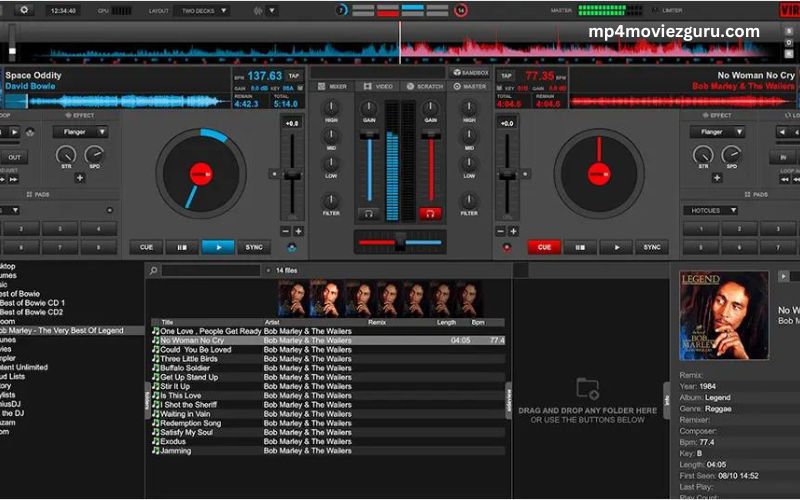Streaming radio has become increasingly popular in recent years, providing music enthusiasts with a vast array of options to choose from. With the advancement of technology, DJs and music lovers can now enjoy streaming radio right from their own computer using software such as Virtual DJ. This article will explore the benefits of playing streaming radio through Virtual DJ, how to do it, and provide tips for finding and selecting the best streaming radio stations.
Benefits of Playing Streaming Radio Through Virtual DJ
Virtual DJ is a powerful software that allows DJs to mix and play music from various sources, including streaming radio. By using Virtual DJ to play streaming radio, you can enjoy numerous benefits. First and foremost, it gives you access to a vast library of music from all over the world. Whether you’re into mainstream hits, underground tracks, or niche genres, you can find a streaming radio station that caters to your musical taste.
Another advantage of using Virtual DJ for streaming radio is the ability to mix and blend tracks seamlessly. With Virtual DJ’s intuitive interface and advanced features, you can transition between songs smoothly, creating a professional DJ experience. Additionally, Virtual DJ offers a variety of effects and filters that can enhance the audio quality of the streaming radio station, allowing you to customize the sound to your preference.
How to Play Streaming Radio Through Virtual DJ
Playing streaming radio through Virtual DJ is a straightforward process. Here’s a step-by-step guide to get you started:
- Download and Install Virtual DJ: Visit the official Virtual DJ website and download the software. Follow the installation instructions to set it up on your computer.
- Launch Virtual DJ: Once installed, open Virtual DJ on your computer. You will be greeted with the main interface, which consists of two decks where you can load and mix tracks.
- Connect to the Internet: Ensure that your computer is connected to the internet. Streaming radio requires an internet connection to access the stations.
- Navigate to the Streaming Radio Section: In Virtual DJ, look for the streaming radio section. It is usually located in the browser pane, where you can find different sources to load music from.
- Select a Streaming Radio Station: Browse through the available streaming radio stations and select the one you want to play. Virtual DJ provides a search function to help you find specific genres or stations.
- Load the Streaming Radio Station: Once you’ve chosen a streaming radio station, click on it to load it into one of the decks in Virtual DJ. You can then start playing and mixing the tracks from the station.
Virtual DJ Features for Streaming Radio
Virtual DJ offers a range of features specifically designed for playing and mixing streaming radio. These features enhance the overall DJ experience and allow you to customize the audio output to your liking. Here are some key features to look out for when using Virtual DJ for streaming radio:
- Real-Time Track Information: Virtual DJ displays real-time information about the currently playing track, including the artist, title, and album. This helps you stay on top of the music being played and allows you to interact with your audience effectively.
- Cue Points and Looping: Virtual DJ allows you to set cue points and loops on the streaming radio tracks. This feature is especially useful for DJs who want to create remixes or extend certain sections of a track during their mix.
- Effects and Filters: Virtual DJ offers a wide range of effects and filters that can be applied to the streaming radio tracks. These effects can enhance the audio quality, add creative elements to your mix, and create a unique sound signature.
- Mixing and Syncing: Virtual DJ includes powerful mixing and syncing capabilities, allowing you to seamlessly transition between tracks from the streaming radio station. This ensures a smooth and professional mix, regardless of the genre or tempo of the music.
Tips for Finding and Selecting Streaming Radio Stations
With the abundance of streaming radio stations available, it can be overwhelming to find the right ones for your DJ sets. Here are some tips to help you discover and select the best streaming radio stations:
- Explore Different Genres: Don’t limit yourself to a single genre. Experiment with various genres of streaming radio stations to broaden your musical horizons and discover new tracks that you can incorporate into your mixes.
- Read Reviews and Recommendations: Look for reviews and recommendations from other DJs or music enthusiasts. They can provide valuable insights into the quality and content of different streaming radio stations.
- Check the Tracklist: Before selecting a streaming radio station, take a look at its tracklist or schedule. This will give you an idea of the type of music played on the station and whether it aligns with your DJ style and audience preferences.
- Consider the Quality: Pay attention to the audio quality of the streaming radio stations. Look for stations that offer high-quality streams, preferably in a lossless format, to ensure the best sound reproduction during your DJ sets.
By following these tips, you can find and select streaming radio stations that cater to your musical preferences and elevate your DJing experience.
Troubleshooting Common Issues When Playing Streaming Radio Through Virtual DJ
While playing streaming radio through Virtual DJ is usually a seamless experience, you may encounter some common issues along the way. Here are some troubleshooting tips to help you overcome them:
- Buffering or Lag: If you experience buffering or lag when playing a streaming radio station, check your internet connection. A slow or unstable connection can cause interruptions in the playback. Try switching to a different streaming radio station or troubleshoot your internet connection.
- Audio Distortion or Dropouts: If you notice audio distortion or dropouts during playback, it could be due to low signal strength or a problem with the streaming radio station’s server. In this case, try selecting a different streaming radio station or contact the station’s support for assistance.
- Compatibility Issues: Ensure that your version of Virtual DJ is compatible with the streaming radio station. Some stations may require specific software versions or plugins to work correctly. Check the station’s requirements and update Virtual DJ if necessary.
- Authentication Errors: Some streaming radio stations may require authentication or login credentials to access their streams. Make sure you have the correct login information and enter it accurately in Virtual DJ’s settings.
By troubleshooting these common issues, you can ensure a smooth and uninterrupted streaming radio experience through Virtual DJ.
Alternative Software Options for Playing Streaming Radio
While Virtual DJ is a popular choice for playing streaming radio, there are alternative software options available that offer similar functionality. Here are a few notable alternatives:
- Serato DJ: Serato DJ is a widely used DJ software that supports streaming radio. It offers a user-friendly interface, advanced mixing features, and seamless integration with popular streaming radio platforms.
- Traktor Pro: Traktor Pro is a professional DJ software that also supports streaming radio. It provides a wide range of features for mixing and remixing tracks, along with extensive support for streaming radio stations.
- Mixxx: Mixxx is a free and open-source DJ software that supports streaming radio. It is a great option for DJs on a budget or those who prefer an open-source solution.
These alternative software options offer different features and user interfaces, so it’s worth exploring them to find the one that best suits your DJing needs.
Enhancing Your DJ Skills with Streaming Radio
Playing streaming radio through software like Virtual DJ not only expands your music library but also enhances your DJ skills. Here are some ways you can use streaming radio to improve your DJing:
- Discover New Tracks: Streaming radio exposes you to a wide range of music from various genres and artists. Take advantage of this opportunity to discover new tracks that you can incorporate into your DJ sets, keeping your mixes fresh and exciting.
- Learn Different Mixing Techniques: Listen to professional DJs on streaming radio stations to learn different mixing techniques and styles. Pay attention to how they transition between tracks, use effects, and build energy throughout their sets. Incorporate these techniques into your own DJing to elevate your performance.
- Stay Updated with Music Trends: Streaming radio stations often feature the latest hits and trends in the music industry. By regularly tuning in to these stations, you can stay up to date with current music trends and ensure that your DJ sets are relevant and appealing to your audience.
- Practice Mixing and Beatmatching: Use streaming radio tracks to practice your mixing and beatmatching skills. Since streaming radio offers a wide variety of tracks, you can challenge yourself by mixing different genres or tempos, improving your overall DJing proficiency.
By leveraging the benefits of streaming radio and incorporating it into your DJing routine, you can elevate your skills, expand your musical knowledge, and create memorable DJ sets.
Conclusion
Playing streaming radio through software like Virtual DJ opens up a world of possibilities for DJs and music lovers. With the ability to access a vast library of music, mix seamlessly, and customize the audio output, Virtual DJ provides a powerful platform for enjoying streaming radio. By following the steps outlined in this article and utilizing the tips provided, you can enhance your DJing experience and take your skills to the next level. So, why wait? Start exploring the world of streaming radio with Virtual DJ today and elevate your DJ sets to new heights.




